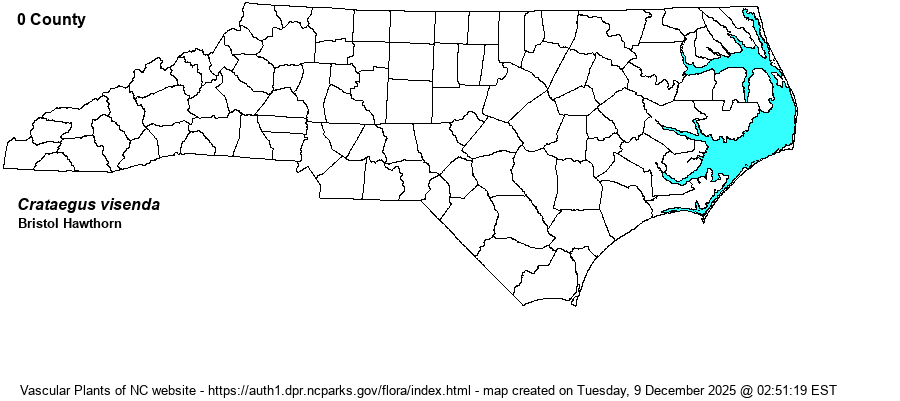| Author | Beadle | |
| Distribution | Ranges in the Sandhills and adjacent parts of the southern Coastal Plain, to an undetermined extent. Apparently ranges barely into the adjacent southeastern Piedmont. Range is very poorly delineated, though Lance's (2014) range map shows a fairly narrow NE-SW finger of the range extending though the Sandhills region to the west-central Coastal Plain. As the editors can locate no specimens or other county data for the species, the range map below must remain unpopulated.
This is a southern species ranging from eastern NC south to northern FL and AL. It ranges well into the Piedmont in GA and AL.
| |
| Abundance | Not well known, but probably uncommon in the Sandhills and probably rare outside of that region. Lance (2014) calls it "rare" in NC, despite its range extending well northward into the state. Weakley's (2018) range map indicates "uncommon" for the Coastal Plain and "rare" for the Piedmont. As with many hawthorn taxa/species, the NCNHP database does not contain this taxon, and thus this website chooses a tentative S3? state rank. | |
| Habitat | As with most other Southern species that range north into southeastern NC, it favors dry and sandy soil, probably mainly in pine-oak stands, disturbed sandy or other xeric ground, etc. Habitats in the state are not well described. |
| Phenology | Blooms in April, and fruits from late August to September. | |
| Identification | This is a large shrub to more often a small tree, ranging to 20-30 feet tall, with many drooping branches. It has noticeably long petioles, almost 1/3rd the length of the leaf blade; the blade is mostly obovate to sub-orbicular, mainly rounded at the base to the petiole. The outer margin is strongly toothed, though lobes are not usually seen. For other distinctions of characters, see Weakley (2018), the Flora of North America website, and Lance (2014); the last reference has this as a variety of C. sororia, a species that ranges north only to SC. Very few observers will be able to identify this species without keying out twigs, and thus be prepared to do so when you are exploring the Sandhills and other sandy sites in the southeastern part of the state. | |
| Taxonomic Comments | As with nearly all hawthorns, it was initially described around 1900, but was forgotten or subsumed within other hawthorns for most of the 20th Century. Though it is not mentioned in RAB (1968), Weakley (2018) says it would have been included within C. flava in that reference. Many references now list C. visenda as a good species, including NatureServe; however, Lance (2014) includes it as a variety of C. sororia and iNaturalist does not contain this taxon.
| |
| Other Common Name(s) | None | |
| State Rank | [S3?] | |
| Global Rank | GNR | |
| State Status | | |
| US Status | | |
| USACE-agcp | | |
| USACE-emp | | |

